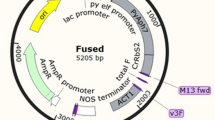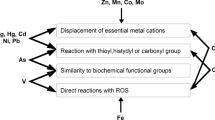Abstract
High carbonate alkalinity is one of the major stress factors for living organisms in saline–alkaline water areas. Acute and chronic effects of carbonate alkalinity on expression of two genes, carbonic anhydrase 2-like (CA2-like) and Na+-K+-ATPase α subunit (NKA-α) mRNA in medaka (Oryzias latipes) were evaluated to better understand the responses important for coping with a carbonate alkalinity stress. In the acute exposure experiment, the expression of CA2-like and NKA-α mRNA in the gill and kidney of medaka were examined from 0 h to 7 days exposed to 30.4 mM carbonate alkalinity water. Exposure to high carbonate alkalinity resulted in a transitory alkalosis, followed by a transient increase in gill and kidney CA2-like and NKA-α mRNA expression. In the chronic exposure experiment, the expression of these two genes was examined in the gill and kidney at 50 days post-exposure to six different carbonate alkalinity concentrations ranging from 1.5 to 30.4 mM. Gill and kidney CA2-like mRNA levels in 30.4 mM were approximately 10 and 30 times higher than that of the control (1.5 mM), respectively. Less differences were found in NKA-α expression in the 50-days exposure. The results indicate that when transferred to high carbonate alkalinity water, a transitory alkalosis may occur in medaka, followed by compensatory acid-base and ion regulatory responses. Thus, CA2-like and NKA-α are at least two of the important factors that contribute to the regulation of alkalinity stress.





Similar content being viewed by others
References
Blanco G, Mercer RW (1998) Isozymes of the Na-K-ATPase: heterogeneity in structure, diversity in function. Am J Physiol-Ren Physiol 275(5):F633–F650
Boyd CE (1992) Water quality and pond soil analyses for aquaculture. Alabama Agricultural Experiment Station. Auburn University, Auburn
Claiborne JB, Edwards SL, Morrison-Shetlar AI (2002) Acid-base regulation in fishes: cellular and molecular mechanisms. J Exp Zool 293(3):302–319
Cutler CP, Sanders IL, Hazon N, Cramb G (1995) Primary sequence, tissue specificity and expression of the \(\text{ Na }^{+}/\text{ K }^{+}\)-ATPase \(\alpha\)1 subunit in the european eel (Anguilla anguilla). Comp Biochem Physiol Part B Biochem Mol Biol 111(4):567–573
Deane EE, Woo NY (2004) Differential gene expression associated with euryhalinity in sea bream (Sparus sarba). Am J Physiol-Regul Integr Comp Physiol 287(5):R1054–R1063
Esbaugh A, Perry S, Bayaa M, Georgalis T, Nickerson J, Tufts B, Gilmour K (2005) Cytoplasmic carbonic anhydrase isozymes in rainbow trout Oncorhynchus mykiss: comparative physiology and molecular evolution. J Exp Biol 208(10):1951–1961
Evans DH, Piermarini PM, Choe KP (2005) The multifunctional fish gill: dominant site of gas exchange, osmoregulation, acid-base regulation, and excretion of nitrogenous waste. Physiol Rev 85(1):97–177
Feng SH, Leu JH, Yang CH, Fang MJ, Huang CJ, Hwang PP (2002) Gene expression of \(\text{ Na }^{+}/\text{ K }^{+}\)-ATPase \(\alpha\)1 and \(\alpha\)3 subunits in gills of the teleost Oreochromis mossambicus, adapted to different environmental salinities. Mar Biotechnol 4(4):379–391
Georgalis T, Gilmour K, Yorston J, Perry SF (2006) Roles of cytosolic and membrane-bound carbonic anhydrase in renal control of acid-base balance in rainbow trout, Oncorhynchus mykiss. Am J Physiol Ren Physiol 291(2):F407–F421
Gilmour K, Perry S (2009) Carbonic anhydrase and acid-base regulation in fish. J Exp Biol 212(11):1647–1661
Goss GG, Wood CM, Laurent P, Perry SF (1994) Morphological responses of the rainbow trout (Oncorhynchus mykiss) gill to hyperoxia, base (NaHCO3) and acid (HCl) infusions. Fish Physiol Biochem 12(6):465–477
Guynn S, Scofield M, Petzel D (2002) Identification of mRNA and protein expression of the Na\(/\)K-ATPase \(\alpha\)1-, \(\alpha\)2- and \(\alpha\)3-subunit isoforms in antarctic and New Zealand nototheniid fishes. J Exp Biol Mar Biol Ecol 273(1):15–32
Hirata T, Kaneko T, Ono T, Nakazato T, Furukawa N, Hasegawa S, Wakabayashi S, Shigekawa M, Chang MH, Romero MF et al (2003) Mechanism of acid adaptation of a fish living in a pH 3.5 lake. Am J Physiol Regul Integr Comp Physiol 284(5):R1199–R1212
James-Curtis B, Wood CM (1992) Kidney and urinary bladder responses of freshwater rainbow trout to isosmotic NaCl and NaHCO3 infusion. J Exp Biol 173(1):181–203
Kang CK, Tsai SC, Lee TH, Hwang PP (2008) Differential expression of branchial \(\text{ Na }^{+}/\text{ K }^{+}\)-ATPase of two medaka species, Oryzias latipes and Oryzias dancena, with different salinity tolerances acclimated to fresh water, brackish water and seawater. Comp Biochem Physiol Part A Mol Integr Physiol 151(4):566–575
Madsen SS, Kiilerich P, Tipsmark CK (2009) Multiplicity of expression of \(\text{ Na }^{+}\)/\(\text{ K }^{+}\)-ATPase \(\alpha\)-subunit isoforms in the gill of atlantic salmon (Salmo salar): cellular localisation and absolute quantification in response to salinity change. J Exp Biol 212(1):78–88
Parra JEG, Baldisserotto B (2007) Effect of water pH and hardness on survival and growth of freshwater teleosts. In: Baldisserotto BKB, Mancera JM (eds) Fish osmoregulation. Science Publishers, Enfield, pp 135–150
Perry S, Gilmour K (2006) Acid-base balance and CO2 excretion in fish: unanswered questions and emerging models. Respir Physiol Neurobiol 154(1):199–215
Randall D, Tsui T (2006) Tribute to RG Boutilier: acid-base transfer across fish gills. J Exp Biol 209(7):1179–1184
Rozen S, Skaletsky H (1999) Primer3 on the www for general users and for biologist programmers. In: Misener S, Krawetz SA (eds) Methods in molecular biology, vol 132: Bioinformatics methods and protocols. Humana Press Inc., Totowa, pp 365–386
Rychlik W (2007) Oligo 7 primer analysis software. In: Yuryev A (ed) Methods in molecular biology, vol 402: PCR primer design. Humana Press Inc., Totowa, pp 35–59
Sattin G, Mager E, Beltramini M, Grosell M (2010) Cytosolic carbonic anhydrase in the gulf toadfish is important for tolerance to hypersalinity. Comp Biochem Physiol Part A Mol Integr Physiol 156(2):169–175
Scheiner-Bobis G (2002) The sodium pump. Eur J Biochem 269(10):2424–2433
Schmittgen TD, Livak KJ (2008) Analyzing real-time PCR data by the comparative CT method. Nat Protoc 3(6):1101–1108
Schönrock C, Morley SD, Okawara Y, Lederis K, Richter D (1991) Sodium and potassium ATPase of the teleost fish Catostomus commersoni. Sequence, protein structure and evolutionary conservation of the \(\alpha\)-subunit. Biol Chem Hoppe-Seyler 372(1):279–286
Scott GR, Richards JG, Forbush B, Isenring P, Schulte PM (2004) Changes in gene expression in gills of the euryhaline killifish Fundulus heteroclitus after abrupt salinity transfer. Am J Physiol Cell Physiol 287(2):C300–C309
Semple JW, Green HJ, Schulte PM (2002) Molecular cloning and characterization of two Na/K-ATPase isoforms in Fundulus heteroclitus. Mar Biotechnol 4(5):512–519
Sumner ME, Naidu R et al (1998) Sodic soils: distribution, properties, management and environmental consequences. Oxford University Press, New York
Thomas S, Poupin J (1985) A study of the effects of water carbonate alkalinity on some parameters of blood acid-base status in rainbow trout (Salmo gairdneri R.). J Comp Physiol B 156(1):29–34
Truchot J, Forgue J (1998) Effect of water alkalinity on gill CO2 exchange and internal PCO2 in aquatic animals. Comp Biochem Physiol Part A Mol Integr Physiol 119(1):131–136
Tufts B, Esbaugh A, Lund S (2003) Comparative physiology and molecular evolution of carbonic anhydrase in the erythrocytes of early vertebrates. Comp Biochem Physiol Part A Mol Integr Physiol 136(2):259–269
Walker GA (2010) Common statistical methods for clinical research with SAS examples. SAS Institute, Cary
Wang H, Lai Q, Fang W, Wang J (2003) Study on aquaculture in different type of saline-alkali water. In: Wang Y (ed) 2003 Forum on fishery science and technology. China Ocean Press, Beijing, p 303
Wang YS, Gonzalez RJ, Patrick ML, Grosell M, Zhang C, Feng Q, Du J, Walsh PJ, Wood CM (2003b) Unusual physiology of scale-less carp, Gymnocypris przewalskii, in Lake Qinghai: a high altitude alkaline saline lake. Comp Biochem Physiol Part A Mol Integr Physiol 134(2):409–421
Wilkie MP, Wood CM (1991) Nitrogenous waste excretion, acid-base regulation, and ionoregulation in rainbow trout (Oncorhynchus mykiss) exposed to extremely alkaline water. Physiol Zool 64(4):1069–1086
Wilkie MP, Wood CM (1996) The adaptations of fish to extremely alkaline environments. Comp Biochem Physiol Part B Biochem Mol Biol 113(4):665–673
Wilkie MP, Wright PA, Iwama GK, Wood CM (1994) The physiological adaptations of the lahontan cutthroat trout (Oncorhynchus clarki henshawi) following transfer from well water to the highly alkaline waters of pyramid lake, nevada (pH 9.4). Physiol Zool 67(2):355–380
Wood CM, Milligan CL, Walsh PJ (1999) Renal responses of trout to chronic respiratory and metabolic acidoses and metabolic alkalosis. Am J Physiol Regul Integr Comp Physiol 277(2):R482–R492
Wood CM, Bergman HL, Bianchini A, Laurent P, Maina J, Johannsson OE, Bianchini LF, Chevalier C, Kavembe GD, Papah MB et al (2012) Transepithelial potential in the magadi tilapia, a fish living in extreme alkalinity. J Comp Physiol B 182(2):247–258
Yao Z, Lai Q, Zhou K, Rizalita RE, Wang H (2010) Developmental biology of medaka fish (Oryzias latipes) exposed to alkalinity stress. J Appl Ichthyol 26(3):397–402
Yao Z, Wang H, Chen L, Zhou K, Ying C, Lai Q (2012) Transcriptomic profiles of japanese medaka (Oryzias latipes) in response to alkalinity stress. Genet Mol Res 11(3):2200–2246
Yesaki TY, Iwama GK (1992) Survival, acid-base regulation, ion regulation, and ammonia excretion in rainbow trout in highly alkaline hard water. Physiol Zool 65(4):763–787
Zhao W (2010) Ecology of inland saline lakes in China. Science Press, Beijing
Acknowledgments
This study was supported by Foundation of Key Laboratory of Yangtze River Water Environment, Ministry of Education (Tongji University), China (No. YRWEF201301) and Special Scientific Research Funds for Central Non-profit Institutes (East China Sea Fisheries Research Institute) (Project NO. 2009M03). We thank Dr. Zhang D., Dr. Mager, E. M and Dr. Esbaugh, A. for their comments on the manuscript. Q. Ding took care of the experimental fish daily.
Conflict of interest
The authors declare no conflict of interest.
Author information
Authors and Affiliations
Corresponding authors
Rights and permissions
About this article
Cite this article
Yao, Z., Lai, Q., Hao, Z. et al. Carbonic anhydrase 2-like and Na+-K+-ATPase α gene expression in medaka (Oryzias latipes) under carbonate alkalinity stress. Fish Physiol Biochem 41, 1491–1500 (2015). https://doi.org/10.1007/s10695-015-0101-6
Received:
Accepted:
Published:
Issue Date:
DOI: https://doi.org/10.1007/s10695-015-0101-6




